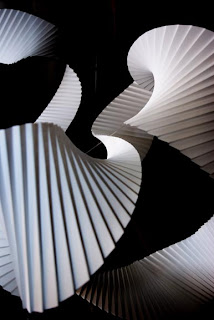Probably one of the most popular paper sculpting designing there is, majority of people have tried or heard about it. I looked into this style of sculpting as just to see an insight on how it could relate to any of the ideas I had in mind. The delicate art of folding small paper to give it character and turn it into an object of meaning is fascinating, but i do think that this style of design wouldn't work with my plans for development stages would work. The ideas I have are lot more architectural.
This image is blooming of colours and the clever paper folding has made it to look like a blossoming flower.
I found that a lot of Origami is heavily influenced by natural forms like flowers. Like I stated before a lot of the worked done is intended to give character and life to paper. Majority of work is all based on natural forms which are living, so this gives the paper a fantasy of life. As the saying goes "Brings it to life"
The other reason I looked into this style of designing is that there is a lot of repartition and repeated patterns as you can see.
Yet again here we have more examples of natural life forms. BARR the unicorn but it is a fantasy life form modelled down into paper. It is really inspiring work.
Through looking at Origami I have discovered that it isn't the style I want to design in but it is the methods and thinking behind the work which i'm after. I want to create a sculpture which has such character and and life simulating elements within the design I create. By this I mean if I considering taking the core structure of buildings and designed paper sculptures which were influenced from this I would want them to have lots of character and personality so that people could relate to them.






























